#1115 - #1120 - Some Stuff From Facebook
#1115 - Nymphid Lacewing Larva

Photo by Brian Everingham, who found it in Sydney under an Cottonwood leaf while gardening, and put it up on Facebook hoping for an ID. I was happy to oblige. :) Nymphid lacewings are also known as Split-toed Lacewings, and include the Blue-eyed Lacewing Nymphes myrmeleonides, a large yellow lacewing with larva that live in the ground and resemble the traditional antlion (hence the myrmeleonides name). Other Nymphid larvae like the one above - probably a Myiodactylus - lurk on plants, long curved jaws ready to snap on anything that wanders within reach. The fringed edges help break up its outline, making it harder for predators and prey to spot. Anything unfortunate enough to be caught by the hooked jaws will be drained of its body fluids by other mouthparts, and then discarded. Other families of lacewings might use the shriveled corpse as part of a disguise. Once the larvae is ready to pupate, it will spin a loose cocoon of silk and debris, and when ready to emerge again chew their way out, and molt into an adult.
#1116 - Pingasa chlora - Flower-eating Moth

AKA White Looper. Photo by Andrea Lim, in Cairns, QLD, and another Facebook post at Amateur Entomology Australia. Also the first moth I IDed without even seeing the dorsal surface, which is grey with fine dark scalloped lines (it helped that Australian Lepidoptera also includes galleries of the undersides of moths) Found in Sundaland, the Philippines, Sulawesi and from the Moluccas to Queensland. Larvae are pests on Rambutan and Lychee crops in Australia. Other food plants include Ribbonwood (Euroschinus falcata),Rose Myrtle (Rhodomyrtus tomentosa, MYRTACEAE ), Silver Ash (Flindersia schottiana, RUTACEAE), and Poison Peach (Trema tomentosa, ULMACEAE).
#1117 - Careades plana
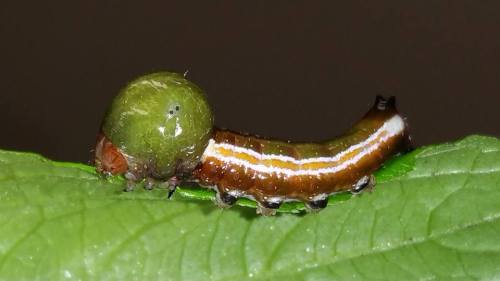
Another post by Andrea Lim, again in Cairns - a caterpillar that appears to have choked to death on a watermelon. Very Hungry Caterpillar you ain’t. Actually, it’s a Nolid caterpillar, and this species isn’t the only one with a gigantically inflated first abdominal segment. It’s been found feeding on Golden Penda and Blake Paperbark in Queensland, and is being investigated as a possible biological control of Paperbarks in Florida. The adult moth isn’t much to write home about, being an undistinguished brown with a few darker blotches.
#1117 - Ctenochares bicolorus - Black-tipped Orange Ichneumon Wasp
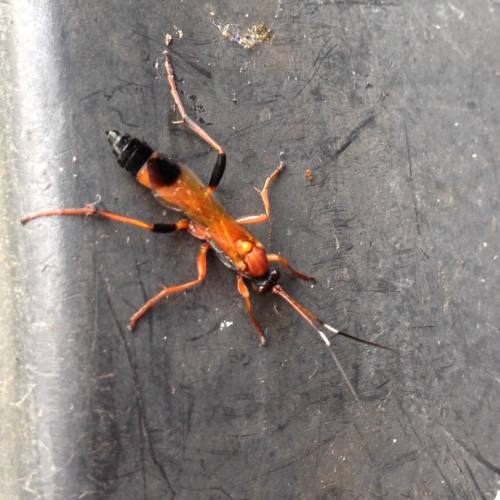
Photo by Tania Sarunic, who found it in Melbourne. Ctenochares are mostly an African genus with 10 described species usually found in savannah habitats. This one is also found in southern Europe around the Mediterranean, and made it to Australia in the 1970s and in New Zealand in 1981.
It parasitises Noctuid moths such as the Tobacco Looper Chrysodeixis argentifera, the Green Garden Looper, Chrysodeixis eriosoma, and the Tropical Armyworm Spodoptera litura. Since those moth species are all pretty common around Perth, I expect I’ll see this wasp around here one of these days.
#1118 - Agathia prasinapsis
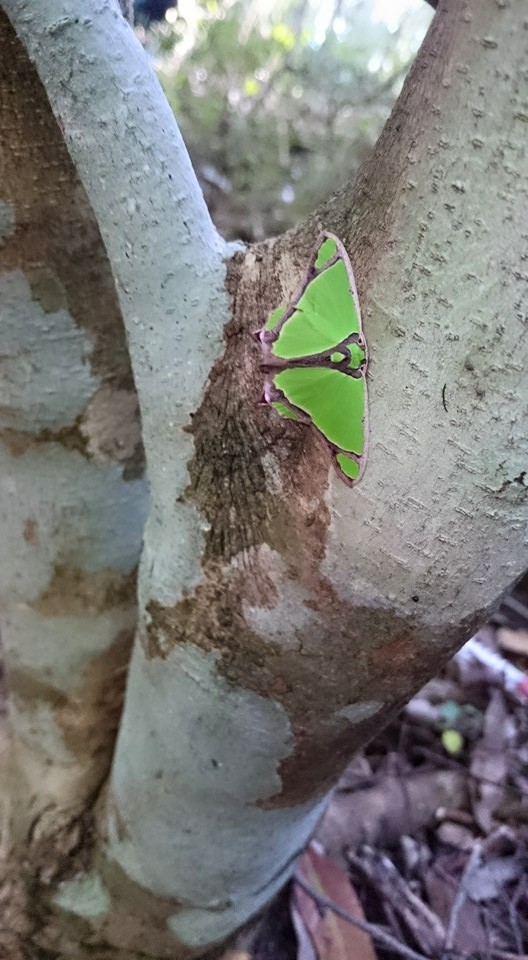
Photo by Damien Moey, in Yarramalong New South Wales. A very pretty Emerald, found in Papua, Queensland, and northern New South Wales. Caterpillars have been found on the vine Gymnanthera oblonga, but apart from that S.F.A. is known about their biology.
#1119 - Beregama sp. Huntsman
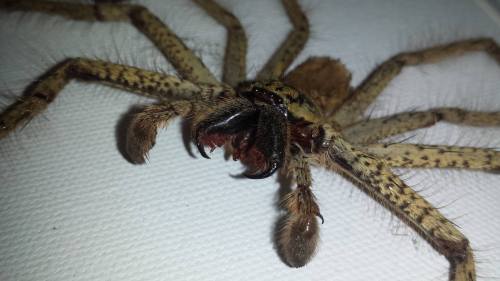
Photo by Emelie Morris in Far North Queensland. Evidently a male, judging by the enormous pedipalps. Nice leopard-print coat, too :) I IDed this on from the spots and his excessive hairiness. Sparassids in this genus tend towards the large side, even for Australia’s justly famous huntsmen, and the Find-a-Spider guide notes for B. aurea that ‘Little is known of the toxicity of this spider so it should be handled with caution though it probably is not very aggressive towards humans’. Emelie can be justly proud of her find.

#1120 - Hypocysta adiante - Orange Ringlet
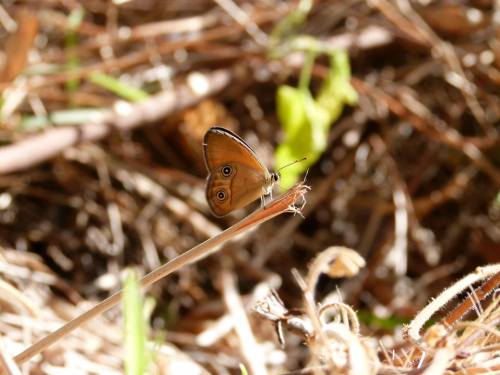
Photo by Gian Luca Carla, Windjana Gorge National Park, in the Kimberley. Small, pretty Nymphalid butterflies, marked with silver rings. There’s two subspecies - this one, H. a. antirius, lives in the Northern Territory and northern Western Australia. The other, H. a. adiante, lives in Queensland and New South Wales. The caterpillars live on native grasses.

Photo by Brian Everingham, who found it in Sydney under an Cottonwood leaf while gardening, and put it up on Facebook hoping for an ID. I was happy to oblige. :) Nymphid lacewings are also known as Split-toed Lacewings, and include the Blue-eyed Lacewing Nymphes myrmeleonides, a large yellow lacewing with larva that live in the ground and resemble the traditional antlion (hence the myrmeleonides name). Other Nymphid larvae like the one above - probably a Myiodactylus - lurk on plants, long curved jaws ready to snap on anything that wanders within reach. The fringed edges help break up its outline, making it harder for predators and prey to spot. Anything unfortunate enough to be caught by the hooked jaws will be drained of its body fluids by other mouthparts, and then discarded. Other families of lacewings might use the shriveled corpse as part of a disguise. Once the larvae is ready to pupate, it will spin a loose cocoon of silk and debris, and when ready to emerge again chew their way out, and molt into an adult.
#1116 - Pingasa chlora - Flower-eating Moth

AKA White Looper. Photo by Andrea Lim, in Cairns, QLD, and another Facebook post at Amateur Entomology Australia. Also the first moth I IDed without even seeing the dorsal surface, which is grey with fine dark scalloped lines (it helped that Australian Lepidoptera also includes galleries of the undersides of moths) Found in Sundaland, the Philippines, Sulawesi and from the Moluccas to Queensland. Larvae are pests on Rambutan and Lychee crops in Australia. Other food plants include Ribbonwood (Euroschinus falcata),Rose Myrtle (Rhodomyrtus tomentosa, MYRTACEAE ), Silver Ash (Flindersia schottiana, RUTACEAE), and Poison Peach (Trema tomentosa, ULMACEAE).
#1117 - Careades plana

Another post by Andrea Lim, again in Cairns - a caterpillar that appears to have choked to death on a watermelon. Very Hungry Caterpillar you ain’t. Actually, it’s a Nolid caterpillar, and this species isn’t the only one with a gigantically inflated first abdominal segment. It’s been found feeding on Golden Penda and Blake Paperbark in Queensland, and is being investigated as a possible biological control of Paperbarks in Florida. The adult moth isn’t much to write home about, being an undistinguished brown with a few darker blotches.
#1117 - Ctenochares bicolorus - Black-tipped Orange Ichneumon Wasp

Photo by Tania Sarunic, who found it in Melbourne. Ctenochares are mostly an African genus with 10 described species usually found in savannah habitats. This one is also found in southern Europe around the Mediterranean, and made it to Australia in the 1970s and in New Zealand in 1981.
It parasitises Noctuid moths such as the Tobacco Looper Chrysodeixis argentifera, the Green Garden Looper, Chrysodeixis eriosoma, and the Tropical Armyworm Spodoptera litura. Since those moth species are all pretty common around Perth, I expect I’ll see this wasp around here one of these days.
#1118 - Agathia prasinapsis

Photo by Damien Moey, in Yarramalong New South Wales. A very pretty Emerald, found in Papua, Queensland, and northern New South Wales. Caterpillars have been found on the vine Gymnanthera oblonga, but apart from that S.F.A. is known about their biology.
#1119 - Beregama sp. Huntsman

Photo by Emelie Morris in Far North Queensland. Evidently a male, judging by the enormous pedipalps. Nice leopard-print coat, too :) I IDed this on from the spots and his excessive hairiness. Sparassids in this genus tend towards the large side, even for Australia’s justly famous huntsmen, and the Find-a-Spider guide notes for B. aurea that ‘Little is known of the toxicity of this spider so it should be handled with caution though it probably is not very aggressive towards humans’. Emelie can be justly proud of her find.

#1120 - Hypocysta adiante - Orange Ringlet

Photo by Gian Luca Carla, Windjana Gorge National Park, in the Kimberley. Small, pretty Nymphalid butterflies, marked with silver rings. There’s two subspecies - this one, H. a. antirius, lives in the Northern Territory and northern Western Australia. The other, H. a. adiante, lives in Queensland and New South Wales. The caterpillars live on native grasses.